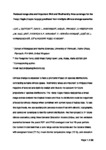Reduced range size and Important Bird and Biodiversity Area coverage for the Harpy Eagle ( Harpia harpyja ) predicted from multiple climate change scenarios
| dc.contributor.author | Sutton, LJ | |
| dc.contributor.author | Anderson, DL | |
| dc.contributor.author | Franco, Miguel | |
| dc.contributor.author | McClure, CJW | |
| dc.contributor.author | Miranda, EBP | |
| dc.contributor.author | Vargas, FH | |
| dc.contributor.author | Vargas González, JDJ | |
| dc.contributor.author | Puschendorf, Robert | |
| dc.date.accessioned | 2022-02-15T21:45:58Z | |
| dc.date.available | 2022-02-15T21:45:58Z | |
| dc.date.issued | 2022-02-14 | |
| dc.identifier.issn | 0019-1019 | |
| dc.identifier.issn | 1474-919X | |
| dc.identifier.uri | http://hdl.handle.net/10026.1/18797 | |
| dc.description.abstract |
<jats:p>Climate change is expected to have a profound impact on species distributions, contracting suitable climate space. Biodiversity areas are important to mitigate these negative effects but are static by design and thus do not account for future projections of species distributions. The Harpy Eagle <jats:italic>Harpia harpyja</jats:italic> has a broad range across lowland Neotropical forests and thus its distribution could be negatively affected by climate change when combined with current rates of habitat loss. To test this hypothesis, we use spatial point process models fitted with climatic, topographical and landcover covariates to identify the current distribution. We then project to 24 future climate scenarios, using three General Circulation Models (GCMs) and two emission scenarios between the years 2021 and 2100 averaged over four, 20‐year periods. Our current model identified a core range across Amazonia and the Guiana Shield, with evergreen forest (71%), mean diurnal temperature range (13%) and elevation (6%) the most important predictors. Reclassifying the current model to a binary prediction estimated a range size of ~ 7.6 million km<jats:sup>2</jats:sup>, with the Important Bird and Biodiversity Area (IBA) network covering 18% of habitat (~ 1.4 million km<jats:sup>2</jats:sup>) within this range. By 2090, range size was predicted to decrease on average by 14.4% under a higher emissions scenario, and 7.3% under a lower emissions scenario. The IBA network would cover 14% less area under a higher emissions scenario, and 3.3% less distribution area under a lower emissions scenario by 2090. Southern Amazonia is predicted to have the greatest reduction in range size and subsequently highest loss of Harpy Eagle habitat within the IBA network. Our work demonstrates that the combination of climate change and subsequent habitat loss may result in substantial losses in distribution for this raptor across the southern edge of its range.</jats:p> | |
| dc.format.extent | 649-666 | |
| dc.language | en | |
| dc.language.iso | en | |
| dc.publisher | Wiley | |
| dc.subject | biodiversity areas | |
| dc.subject | conservation planning | |
| dc.subject | global warming | |
| dc.subject | Harpia harpyja | |
| dc.subject | Species Distribution Models | |
| dc.title | Reduced range size and Important Bird and Biodiversity Area coverage for the Harpy Eagle ( Harpia harpyja ) predicted from multiple climate change scenarios | |
| dc.type | journal-article | |
| dc.type | Journal Article | |
| plymouth.author-url | https://www.webofscience.com/api/gateway?GWVersion=2&SrcApp=PARTNER_APP&SrcAuth=LinksAMR&KeyUT=WOS:000754606100001&DestLinkType=FullRecord&DestApp=ALL_WOS&UsrCustomerID=11bb513d99f797142bcfeffcc58ea008 | |
| plymouth.issue | 3 | |
| plymouth.volume | 164 | |
| plymouth.publication-status | Published | |
| plymouth.journal | Ibis | |
| dc.identifier.doi | 10.1111/ibi.13046 | |
| plymouth.organisational-group | /Plymouth | |
| plymouth.organisational-group | /Plymouth/Faculty of Science and Engineering | |
| plymouth.organisational-group | /Plymouth/Faculty of Science and Engineering/School of Biological and Marine Sciences | |
| plymouth.organisational-group | /Plymouth/REF 2021 Researchers by UoA | |
| plymouth.organisational-group | /Plymouth/REF 2021 Researchers by UoA/UoA06 Agriculture, Veterinary and Food Science | |
| plymouth.organisational-group | /Plymouth/Users by role | |
| plymouth.organisational-group | /Plymouth/Users by role/Academics | |
| dcterms.dateAccepted | 2022-01-06 | |
| dc.rights.embargodate | 2023-2-14 | |
| dc.identifier.eissn | 1474-919X | |
| dc.rights.embargoperiod | Not known | |
| rioxxterms.versionofrecord | 10.1111/ibi.13046 | |
| rioxxterms.licenseref.uri | http://www.rioxx.net/licenses/all-rights-reserved | |
| rioxxterms.licenseref.startdate | 2022-02-14 | |
| rioxxterms.type | Journal Article/Review |


